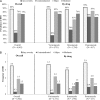Drug-Drug Interaction Associated with Mold-Active Triazoles among Hospitalized Patients
- PMID: 27001815
- PMCID: PMC4879403
- DOI: 10.1128/AAC.00054-16
Drug-Drug Interaction Associated with Mold-Active Triazoles among Hospitalized Patients
Abstract
The majority of hospitalized patients receiving mold-active triazoles are at risk of drug-drug interactions (DDIs). Efforts are needed to increase awareness of DDIs that pose a serious risk of adverse events. Triazoles remain the most commonly utilized antifungals. Recent developments have included the mold-active triazoles (MATs) itraconazole, voriconazole, and posaconazole, which are first-line agents for the treatment of filamentous fungal infections but have the potential for DDIs. This objective of this study was to evaluate the prevalence of triazole DDIs. Hospitalized U.S. adults with MAT use were identified in the Cerner HealthFacts database, which contained data from over 150 hospitals (2005 to 2013). The severities of DDIs with MATs were categorized, using drug labels and the drug information from the Drugdex system (Thompson Micromedex), into four groups (contraindicated, major, moderate, and minor severity). DDIs of minor severity were not counted. A DDI event was considered to have occurred if the following two conditions were met: (i) the patient used at least one drug with a classification of at least a moderate interaction with the MAT during the hospitalization and (ii) there was a period of overlap between the administration of the MAT and that of the interacting drug of at least 1 day. A total of 6,962 hospitalizations with MAT use were identified. Among them, 88% of hospitalizations with voriconazole use, 86% of hospitalizations with itraconazole use, and 93% of hospitalizations with posaconazole use included the use of a concomitant interacting drug. A total of 68% of hospitalizations with posaconazole use, 34% of hospitalizations with itraconazole use, and 20% of hospitalizations with voriconazole use included the use of at least one drug with a DDI of contraindicated severity. A total of 83% of hospitalizations with posaconazole use, 61% of hospitalizations with itraconazole use, and 82% of hospitalizations with voriconazole use included the use of at least one drug that resulted in a severe DDI. The findings of this study demonstrate that a majority of hospitalized patients receiving MAT are at risk for severe drug-drug interactions and highlight the need for antifungal stewardship.
Copyright © 2016, American Society for Microbiology. All Rights Reserved.
Figures
Similar articles
-
Effect of Preexposure to Triazoles on Susceptibility and Virulence of Rhizopus oryzae.Antimicrob Agents Chemother. 2015 Dec;59(12):7830-2. doi: 10.1128/AAC.01583-15. Epub 2015 Sep 21. Antimicrob Agents Chemother. 2015. PMID: 26392499 Free PMC article.
-
In vitro susceptibility testing of Aspergillus spp. against voriconazole, itraconazole, posaconazole, amphotericin B and caspofungin.Chin Med J (Engl). 2010 Oct;123(19):2706-9. Chin Med J (Engl). 2010. PMID: 21034656
-
In vitro susceptibility of filamentous fungi to itraconazole, voriconazole and posaconazole by Clinical and Laboratory Standards Institute reference method and E-test.Mycoses. 2011 Sep;54(5):e318-22. doi: 10.1111/j.1439-0507.2010.01913.x. Epub 2010 Jun 14. Mycoses. 2011. PMID: 20557462
-
New triazoles and echinocandins: mode of action, in vitro activity and mechanisms of resistance.Expert Rev Anti Infect Ther. 2009 Oct;7(8):981-98. doi: 10.1586/eri.09.67. Expert Rev Anti Infect Ther. 2009. PMID: 19803707 Review.
-
Update on azole antifungals.Semin Respir Crit Care Med. 2008 Apr;29(2):198-210. doi: 10.1055/s-2008-1063858. Semin Respir Crit Care Med. 2008. PMID: 18366001 Review.
Cited by
-
Azole drugs have differential efficacy in varied models of immunosuppression in larval zebrafish hosts.Future Microbiol. 2025 Aug;20(12):793-806. doi: 10.1080/17460913.2025.2539639. Epub 2025 Aug 3. Future Microbiol. 2025. PMID: 40754843 Free PMC article.
-
Challenges in the Treatment of Invasive Aspergillosis in Immunocompromised Children.Antimicrob Agents Chemother. 2022 Jul 19;66(7):e0215621. doi: 10.1128/aac.02156-21. Epub 2022 Jun 29. Antimicrob Agents Chemother. 2022. PMID: 35766509 Free PMC article. Review.
-
Triazole antifungal drug interactions-practical considerations for excellent prescribing.J Antimicrob Chemother. 2024 Jun 3;79(6):1203-1217. doi: 10.1093/jac/dkae103. J Antimicrob Chemother. 2024. PMID: 38629250 Free PMC article. Review.
-
Sepsis Surveillance Using Adult Sepsis Events Simplified eSOFA Criteria Versus Sepsis-3 Sequential Organ Failure Assessment Criteria.Crit Care Med. 2019 Mar;47(3):307-314. doi: 10.1097/CCM.0000000000003521. Crit Care Med. 2019. PMID: 30768498 Free PMC article.
-
New Perspectives on Antimicrobial Agents: Isavuconazole.Antimicrob Agents Chemother. 2022 Sep 20;66(9):e0017722. doi: 10.1128/aac.00177-22. Epub 2022 Aug 15. Antimicrob Agents Chemother. 2022. PMID: 35969068 Free PMC article. Review.
References
Publication types
MeSH terms
Substances
LinkOut - more resources
Full Text Sources
Other Literature Sources
Medical
Miscellaneous



